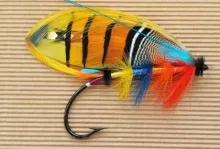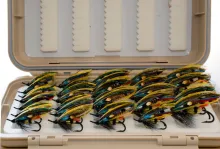This book is pretty exotic and definitely not for the average fly tyer. But if you are interested in classic salmon flies and their history, it's a book you must have on your shelves.
Updated or edited 9 months ago
When I'm with my good friend and master fly tyer Niels Have we often talk about classic salmon flies. I very rarely tie them, but Niels very often does, and he is very good at it, which I am not. He can tie the meanest and most beautiful looking, full dressed fly with all the bells and whistles, worthy of the finest frame and best spot on the wall in any fishing cabin. But in my eyes the best looking classic flies he ties, are actually the ones he ties for fishing. He often refers to flies from Hardy, Farlows and flies from the hands of tyers like Megan Boyd when he talks about the desired style of his fishing flies.
Tying a salmon fly with a high and fancy wing, adorned with all kinds of exotic materials, arced by a huge GP crest and featuring macaw, jungle cock, parrot feathers and such rarities is fine, but is usually something that's tied to be displayed. They wouldn't last a minute on a fly line, and putting them on one today would be basically unthinkable and definitely sacrilegious.
Niels' flies have low riding wings, are built dense and compact, tied for robustness and will not only fish well, but also last. Niels fishes them and has caught fish on them.
Looking in this book you will see lots of flies like Niels'. Back in the late 1800's and well into the 20th century, these flies were tied to fish, and when you look at the many original flies shown here, you realize that these were made for fishing.
In keeping with the history and origin of these patterns, you will see lots of exotic bird feathers, fancy tinsels and flies featuring many different materials used in complex ways. Times were different, and the feathers, which are now illegal to use or just hard to find, were used extensively back then. Also time was less expensive, and spending man hours tying hand crafted flies was the way things were done. But even though they are tied with these extraordinary materials and many tying steps, they reek of fishing.
The book is, as the title says, simply a rundown of the flies featured in Farlows' catalog. Now, "simply a rundown" makes it sound like a plain listing, but trust me, there's nothing plain about the listings and the work put into this registration.
The author, Martin Lanigan-O'Keeffe, must have spent almost innumerable hours in going through the old registers, the pattern books and the physical flies. The introduction reveals a little about the scope of this odious task, and mentions some of the things the author has battled. Flies mislabeled or without labels, the influence of time on the documents and the flies themselves, the coordination with other enthusiasts spread around the world and the amount of research into other books, magazines and catalogs. It's not trivial to record and organize all this information, and definitely an almost Sisyphean task gathering it all into a book.
Well, Lanigan-O'Keeffe's rock didn't roll down the hill again, but rolled out of the printing press in the form of this beautiful book.
And it is beautiful.
To the innocent bystander it may look like just pages up and pages down of pictures of flies in an ocean of bits of text – and it is. But for the interested fly tyer or historian it's a treasure trove of information and an endless source of inspiration for tying.
These are classic salmon flies, and as such I was expecting to be able to recognize most, but I have to admit that I was somewhat surprised by the flies.
They surprised me in two ways.
First of all there are so many patterns that I never heard about. That's a very positive surprise, and just made the reading more exiting and more enlightening.
Secondly the flies appear not only very fishy, but some of them downright crude. Don't get me wrong here, but we're so used to seeing the beautifully tied classic salmon flies of today. Many of the flies here cannot be called beautiful or elegant in that sense. They are in many ways the jeans and overalls of the fly tying industry - OK, some more like prêt-à-porter - compared to the haute couture of Dior, Balmain or Chanel, which is represented by the more gaudy flies like those tied by Traherne.
Of course time hasn't been gentle on these flies, of which some are probably more than 100 years old, so discolored feathers and tarnished tinsels are to be expected. But looking at the shapes of bodies, regularity of ribs, placement of hackles, butts, veilings and such, you realize that these weren't tied for beauty, but for efficiency, and definitely not for framing, but to put in a flybox and from there into a river and finally in the mouth of a fish. These are fishing flies.
They are in many ways the jeans and overalls of the fly tying industry
So even though this is a cover-to-cover feast for the eyes, it's not classic salmon flies in the "modern" sense. They are not anywhere near the immaculate flies in books like Judith Dunham's "The Atlantic salmon fly". It's not even the old school classic style like you have seen them in Sven Olov Hård's fantastic book "Tied in the Hand".
They are however truly inspiring and fascinating, and will make people like me want to dive into classic salmon fly tying, realizing that these are not necessarily works of art, but simply fishing flies from another era. The patterns and styles show clearly that classic salmon flies are much more than Fra Diavolos, Durham Rangers and Green Highlanders.
The book is not a typical coffee table book, even though the format and size easily justifies it as one. The print is beautiful, and the layout impeccable, but the structure of the book is more like a lexicon, and this style doesn't lend itself well to awing people in the same way as say the two books mentioned above. The book has lots of documentation in the form of photos and transcripts of old documents, and also contains systematic lists and tables, which will probably only be interesting to the die hard enthusiast, with interest in this phenomenal historic record of the flies.
But to a curious fly tyer and the classic salmon fly tyer in particular, the book is a fantastic resource and an almost endless row of tying ideas.
- Log in to post comments









